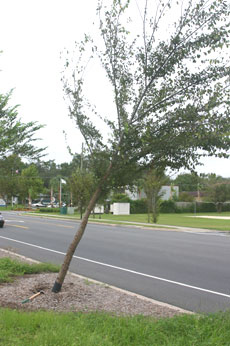by Sara Williams
My first serious tree planting began after I moved to a then treeless bromegrass pasture of five acres south of Saskatoon over forty years ago. Purchased in the winter, I had no idea of what the soil was like. And after the heavy clay soil of a Sutherland home, I was not quite sure what to do with the almost pure sand of the acreage. Friends commented on the somewhat “rolling terrane” of the back pasture – so sandy that it had indeed blown to form a few small undulating dunes during the dry dirty thirties.
Guidelines for planting trees have changed somewhat over those four decades but the principles remain. Many of the problems associated with tree planting come from letting them dry out between the time of purchase and the time of planting, encircling roots, placing the tree at the wrong depth, too small a planting hole or unnecessary staking.
Although it might seem counter-intuitive, adding an overabundance of organic amendments to the planting home, especially in a heavy clay soil, may result in the roots never leaving the hole to venture out into the surrounding soil.
The ideal planting time is spring as it provides the longest time frame for the tree to become established. Summer also works as long as attention is paid to weather that is too hot, too dry or too windy and the tree is watered accordingly. Early fall is also an option – as long as the tree is in active growth but has enough time to harden off (cease growth and prepare for winter) in its new home.
Most trees do best in full sun and well-drained soil. Before planting, check with utility companies to avoid placing trees on top of hidden underground utilities. And look up to ensure they will not be growing into overhead utility lines.
Small trees are usually sold in containers while larger ones may be “balled and burlapped.” Large orders of smaller trees may be bare-rooted. Always handle trees by their lower trunks.
When removing the tree from its container, minimal damage occurs if this is done while the tree and container are laying on their side. If balled-and-burlapped, remove all wrapping materials. Soak the root ball for a few hours in (preferably) lukewarm water. If any roots are circling, spiraling or girdling the root ball or growing inward, they should be straightened out so they grow away from the root ball, not into it or around it. If gently re-positioning the roots does not work, then cut them off with a sharp pruner. Consider this a “kind cut”. New roots will quickly form and be heading in the right direction. If left to grow inward or circle around, they will in effect strangle themselves. At the time of planting, only prune dead, diseased or broken branches.
Trees should be planted at the same depth at which they were grown in their container or in the nursery field, at a mid-point in the “trunk flare.” This is where the trunk bulges or broadens slightly before the roots begin. It is important that the trunk is above the soil line and the roots below the soil line.
I found the most success on my sandy soil when digging a generous planting hole. Take a cue from the lyrics of Michael, Row Your Boat Ashore, “The Jordan River is deep and wide, Hallelujah!” Sing while you dig and dig both deep and wide. The depth of the planting hole should be about four inches deeper than the depth of the root ball; the width at least twice that of the root ball. Err on the side of generosity. If needed, place a mound of soil on the bottom of the planting hole to ensure that the planting level is neither too high nor too deep.
Recommendations have changed a bit in forty years, but if your soil is predominantly sand, adding moderate amounts of organic amendments such as compost, peat moss or composted manure to the soil in the planting hole will help to retain moisture. Otherwise, go with the soil that you have.
Next – Part 2 – Planting!
Sara Williams is the co-author, with Bob Bors, of Growing Fruit in Northern Gardens.
This column is provided courtesy of the Saskatchewan Perennial Society (SPS; saskperennial@hotmail.com ). Check our website saskperennial.ca) or Facebook page (facebook.com/saskperennial). All Saskatchewan Perennial Society events are on hold until further notice.


